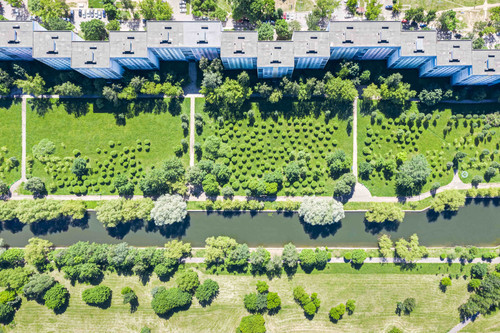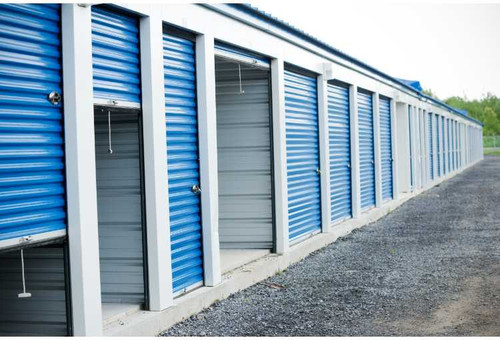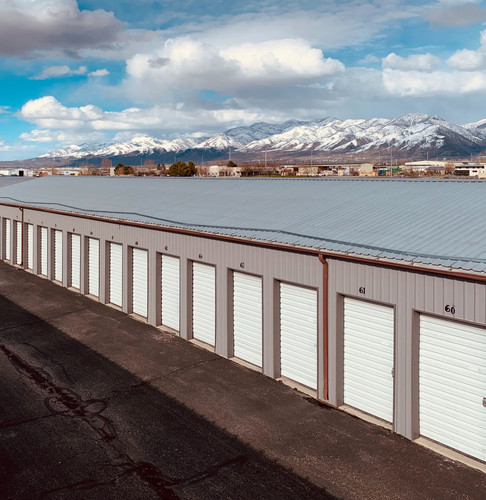How Many Storage Units Sizes Fit per Acre? (2026 Guide)
Maximize your storage facility's potential with our guide on "how many storage units per acre". Learn the optimal unit-to-land ratio for maximum profits.

If you’ve been thinking about how many storage unit sizes you can fit into an acre, you’re not alone. It is one of the most frequently asked questions among people looking to start a new self storage business.
The process of setting up a self storage facility from start to finish will begin with your initial research into the number of facilities you can set up and end with choosing the right self storage management software.
This guide answers all your initial questions about how many storage units per acre are feasible for a business owner. Once you have decided on this, make sure to read the next steps you need to take in starting a self storage business. Let’s dig in and explore the details.
How Big is an Acre of Land?
Before estimating how many storage unit sizes per acre, you need to understand what the size of an acre of land is in terms of the space it offers. An acre of land is about 43,560 square feet of space.
From the real estate perspective, you can fit in around 15 average-sized homes on one acre of land. All these calculations and estimation indicates that one acre of land is a pretty spacious area.
Download the ultimate Self Storage e-book
Everything you need to know about setting up your self-storage facility.
Download for FREEWhat is the Average Size of a Storage Facility?
Self storage facilities can range from 10,000 and 100,000 square feet. The average size of a storage facility in the US is around 56,000 square feet and 46,000 net rentable square feet. Most self storage facilities that are built on one acre of land are multi-story with advanced self storage management software to monitor operations remotely.

What is the Average Number of Units in a Self Storage Facility?
According to ProjectionHub, a survey of 10,000 storage unit sizes shows that the average number of storage units per facility is 546. This represents the units in an average self storage unit with around 46,000 and 50,000 net rentable square feet of space.
Most storage facilities aim for an occupancy rate of 80% to 90%. On average, a facility with about 50,000 square feet of rentable space can generate between $90,000 and $600,000 each year, depending on how many units are rented and the local rental rates.
2 Factors Affecting the Number of Units per Acre
Several factors affect the number of storage units you build in a storage facility, with the two most important being units mix and coverage rates.
Units Mix
Will your storage facility units all be the same size or a mix of different sizes? What is the ideal size of a storage unit according to your customers? If your target customers are homeowners, you can build more 10x10 storage unit options. On the other hand, consider a smaller unit size for apartment renters and a larger size for businesses.
Coverage Rates
The coverage rate refers to the percentage of land or property that is covered by a building or structure. In the context of storage facilities, it specifically refers to the percentage of land that is covered by storage units.
The coverage rate of a storage facility depends on several factors, such as local zoning regulations, building codes, and the specific layout and design of the facility. The coverage rate of your storage facility decides how many storage units per acre you can fit in. Self storage facilities averagely have a coverage rate between 30% and 50%. The maximum limit usually does not exceed 50% in all storage facilities.
The coverage rate of your storage facility decides how many storage units per acre you can fit in. Self-storage facilities usually have a coverage rate between 30% and 50%. Most facilities do not go above 50% because space is needed for driveways, parking, and required setbacks.
How Many Storage Units Per Acre?
Let’s find out the number of storage units per acre you can easily fit in depending on the type of self storage facility. Although one acre equals 43,560 square feet of space, you do not have 43,560 square feet of buildable space.
Simply dividing 43,560 by the size of the storage units you want to build will not work.
A self storage facility has other things also, such as the driveway and water runoff. Depending on how often storage units get broken into in your area, you will need space for fencing and other security measures.
Due to this, the average buildable space available on one acre of land is about 13,000 to 21,780 square feet, depending on the layout and local rules.
The number of units depends on the unit mix you choose. For simplification purposes, let’s assume that you will build only 10 by 10 storage unit options. Each unit will consume around 100 square feet of space; thus, you can fit 150-200 storage units in an acre of land.
Each 10x10 unit uses about 100 square feet of space, so you can fit between 130 and 215 storage units per acre, depending on the coverage rate and layout.
If you build a multi-story facility, you can fit even more units on the same acre of land. Multi-story buildings cost more to build but can double or triple the number of units. Construction costs for self storage facilities usually range from $25 to $70 per square foot, depending on the type of building and materials used. Operating costs are about 35% of the revenue and include taxes, insurance, and maintenance.
For Boat and RV Storage
If you are building boat and RV storage, you have to build parking stalls instead of storage units. On average, a parking stall is around 350 square feet. Based on this assumption, you can build 60 to 70 parking stalls on an acre.
Boat and RV storage may have different requirements for driveways and turning space, so the number of parking stalls can be lower if the vehicles are large or if extra-wide drive aisles are needed.
5 Important Considerations for Storage Units
When planning a storage facility, determining the storage unit sizes that can fit per acre is critical.
Here are 5 key factors to consider to optimise your storage unit capacity:
-
Unit size and layout
-
Building size and zoning regulations
-
Required setbacks and parking spaces
-
Access and circulation
-
Utilising technology and automation

1. Unit Size and Layout
The size and layout of your storage units play a significant role in determining how many units can fit per acre. It’s crucial to carefully analyse the dimensions of your units— whether a 10 by 10 storage unit or 10 x 20 storage unit—and design an efficient layout that maximises space utilisation. Consider factors such as aisle widths, unit access, and circulation space to ensure a well-organised facility accommodating more storage units.
Some facilities use automated storage systems or stackable units to increase the total number of units per acre, especially in cities where land is expensive.
2. Building Height and Zoning Regulations
The height of your storage building and local zoning regulations can impact the number of units you can fit per acre. Some areas have restrictions on building height, which can limit vertical storage space. By understanding and complying with zoning regulations, you can optimise your storage design within the given parameters and potentially increase the number of units per acre.
Check if your area allows multi-story buildings. Multi-story storage can help you fit more units on the same land, but you may need elevators or ramps for customer access.
3. Required Setbacks and Parking Spaces
How much is a storage unit supposed to occupy in an acre? Municipalities often require setbacks and parking spaces around storage buildings for safety and accessibility. These requirements can reduce the available space for storage units. Familiarising yourself with local building codes, designing your facility accordingly, and ensuring compliance while maximizing your storage capacity is essential.
Parking requirements and setbacks can take up a lot of space. Make sure to ask your local government about the rules before planning your layout.

4. Access and Circulation
Efficient access and circulation are vital for a successful storage facility. Consider incorporating wide driveways and clear pathways that allow easy maneuvering of moving trucks and customers’ vehicles. Optimizing access and circulation can enhance the overall efficiency of your storage facility and accommodate more storage unit sizes per acre.
Wide driveways are important for moving trucks and trailers. Proper planning of access can help you fit more units and make your facility easier to use.
5. Utilising Technology and Automation
Innovative technologies, such as automated storage systems and smart unit management, can significantly increase the number of units per acre. These advanced systems optimise vertical storage space and enable efficient retrieval and management of stored items. By embracing technology, you can maximise your storage capacity and streamline operations.
Using self storage management software can help you track unit availability, accept online payments, and reduce the need for on-site staff. This can make your business more efficient and profitable.
Is a Storage Facility a Good Investment?
When you plan to build a storage facility on an acre of land, you may ask yourself whether owning a self storage unit business is profitable. In short - yes, it is! You can do many profitable things with an acre of land, and storage development is one of them.

Owning a self storage facility in a high-demand area is a very lucrative business opportunity. All you need to do is understand your customer, collect market information, and use automated self storage software to effectively execute your business plan. Additionally, with the potential for attractive returns and a steady stream of rental income, investing in a self storage facility presents a compelling property investment opportunity for savvy entrepreneurs and investors.
The average return on investment for self storage facilities in the US has been strong, with an average internal rate of return (IRR) of about 16.9% over the past decade. Many investors see self storage as a safe and steady way to earn income from real estate.
Frequently Asked Questions
How Do I Calculate How Much Storage Space I Need?
To calculate how much storage space you need, multiply your belongings’ length, width, and height. For example, if your larger items make a pile that measures 5 feet in length, 5 feet in width, and 5 feet in height, you would need a storage unit with at least 75 cubic feet of space. This calculation helps you determine the appropriate storage size for your belongings.
How Big is a 10 by 10 Storage Unit?
A 10 by 10 storage unit is 10 feet wide and 10 feet long, amounting to a total area of 100 square feet. It’s big enough to store various items like furniture, boxes, and equipment. It can be a good option if you need extra space to store your belongings.
What is the Most Popular Size Storage Building?
The most popular size storage building is the 10 by 10 storage unit. It’s a medium-sized space, about 100 square feet, which is half the size of a regular garage. This size is very versatile and can hold the belongings of a two-bedroom apartment, including all the boxes and totes. So, if you need storage space, the 10’x10’ unit is popular!
How Many Square Feet is a 10x20 Storage Unit?
A 10x20 storage unit has an area of 200 square feet. To determine the square footage, you multiply the length (10 feet) by the width (20 feet). This gives you the total area inside the storage unit. If you’re looking for a storage unit that is 10 feet wide and 20 feet long, you can expect it to have around 200 square feet of space for storing your belongings.
How Big is a 10x15 Storage Unit?
A 10x15 storage unit has an area of 150 square feet and will fit various items. You can store the contents of a large one-bedroom apartment, including furniture like a couch, bed, dining table, and appliances. Additionally, you’ll have space for multiple boxes, clothing, and other personal belongings. This size is also suitable for storing business inventory, office furniture, or equipment.